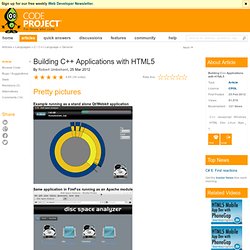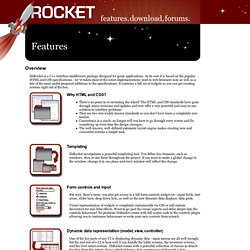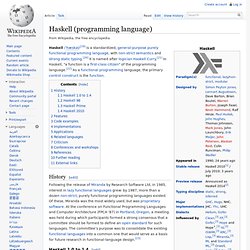

D3.js - Data-Driven Documents. Building C++ Applications with HTML5. Pretty pictures Example running as a stand alone Qt/Webkit application Same application in FireFox running as an Apache module Downloads Disk Space Analyzer Demo Application Source Code Introduction HTML5 is a great way to create rich, platform-independent User Interfaces.

In this article, I'm going to attempt to help bridge the gap between HTML5 and C++ so that we can use HTML5 to create the UI portion of stand alone C++ applications. WebKit A KHTML forked browser engine that is very solid and easy to compile and use. Qt A platform-independent native application framework developed by Trolltech and recently acquired by Nokia. Qt has what is probably the easiest to use WebKit integration, and our framework surrounding it is going to be very minimal. Motivation Some reasons you might want to use HTML5 for UI development: Web tools are probably the fastest, most cost effective and well understood method of creating UI's currently available. Goals So let's lay down some objectives.
Taming C++ <html><? Features - libRocket. LibRocket is a C++ interface middleware package designed for game applications.

At its core it is based on the popular HTML and CSS specifications - we've taken most of the latest implementations used in web browsers now as well as a few of the most useful proposed additions to the specifications. It contains a full set of widgets so you can get creating screens right out of the box. Why HTML and CSS? ¶ There's no point in re-inventing the wheel! Templating ¶ libRocket incorporates a powerful templating tool. Form controls and input ¶ But wait, there's more: you also get access to a full form controls widget set - input fields, text areas, slider bars, drop down lists, as well as the new dynamic data displays, data grids.
Visual representation of widgets is completely customisable via CSS or add custom decorators for real-time effects. Chapter 2. Types and Functions. Why functional programming? Why Haskell? Haskell (programming language) Haskell /ˈhæskəl/[19] is a standardized, general-purpose purely functional programming language, with non-strict semantics and strong static typing.

It is named after logician Haskell Curry. In Haskell, "a function is a first-class citizen" of the programming language.[22] As a functional programming language, the primary control construct is the function. The first version of Haskell ("Haskell 1.0") was defined in 1990. The committee's efforts resulted in a series of language definitions (1.0, 1.1, 1.2, 1.3, 1.4). In February 1999, the Haskell 98 language standard was originally published as "The Haskell 98 Report".
In early 2006, the process of defining a successor to the Haskell 98 standard, informally named Haskell Prime, began.[25] This is an ongoing incremental process to revise the language definition, producing a new revision up to once per year. The following is a Hello world program written in Haskell (note that all but the last line can be omitted): JVM-based:
Ssh. GIMP. C. Bash commands - Linux MAN Pages. Emacs.